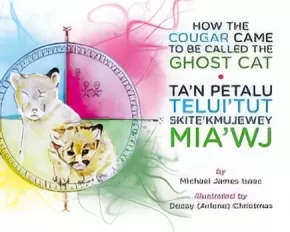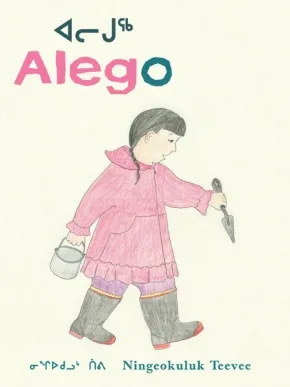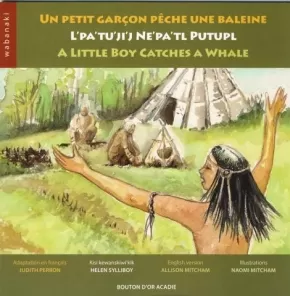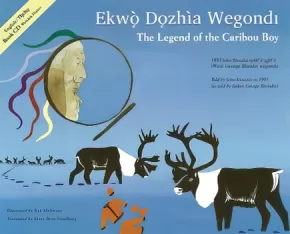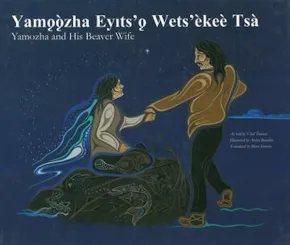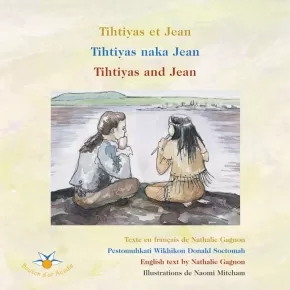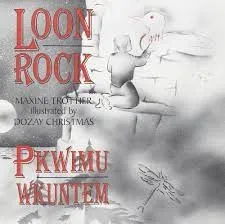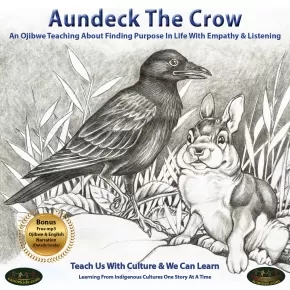
Dual or Triple Language
166
-
180
of
181 Results;
Sort By
Go To
of 13
Call of the Fiddle
$17.50
Artists:
Format:
Paperback
Text Content Territories:
Indigenous Canadian; Métis;
ISBN / Barcode: 9781926795041
Synopsis:
Synopsis:
Call of the Fiddle completes the trilogy of a young boy as he embraces his Métis heritage and carries on his family’s traditions. Wilfred Burton and Anne Patton capture Batoche’s history and significance with their words, while Sherry Farrell Racette brings the land and Métis culture to life with her vibrant illustrations. Join Nolin one last time as he hears the rollicking rhythm of the “Red River Jig,” learns of tearful memories, and experiences the excitement of jigging at Batoche!
Includes a CD with English and Michif Narrations of the Story and Fiddle Music!
Educator & Series Information
The trilogy is composed of these three titles: Fiddle Dancer, Dancing In My Bones, and Call of the Fiddle.
Michif translations by Normal Fleury.
Additional Information
49 Pages | 27.9 cm x 21.5 cm
Fox on the Ice
$12.95
Artists:
Format:
Paperback
Text Content Territories:
Indigenous Canadian; First Nations; Cree (Nehiyawak);
ISBN / Barcode: 9781897252666
Synopsis:
Synopsis:
One winter afternoon, Joe and Cody went ice fishing with their papa, their mama, and Cody's little black dog, Ootsie. It was the perfect day to fish. The sky was clear, and the sun made the snow sparkle like diamonds.
Brothers Joe and Cody are spending a chilly winter afternoon ice fishing with their parents. Cody is helping Papa fish, while Mama and Joe doze in the sled. Suddenly the sled dogs sit up and sniff. A fox is across the lake, her fur as bright as flames. The sled dogs give chase, pulling Mama and Joe along on a wild ride.
Written in both English and Cree, Fox on the Ice is a wonderful, lyrical story of celebration from award-winning author Tomson Highway, capturing a passing way of life for future generations. Illustrator Brian Deines has created an evocative masterpiece of shimmering oils depicting the beauty of northern Manitoba.
Educator & Series Information
This is the second book in the Songs of the North Wind series, a dual-language (English and Cree) series about two young Cree boys.
This book is available in French/Cree: Un renard sur la glace / Maageesees Maskwameek Kaapit
Additional Information
32 pages | 8.50" x 10.25"
How the Cougar Came to be Called the Ghost Cat
$12.95
Artists:
Format:
Paperback
Text Content Territories:
Indigenous Canadian; First Nations; Mi'kmaq;
ISBN / Barcode: 9781552663714
Synopsis:
Synopsis:
The story of Ajig the cougar, who is trapped between two worlds, A symbol of the assimilation of First Nations through enforced Western education systems.
The human need to belong is very powerful, so much so that we often sacrifice parts of who we are in order to be accepted. This is the tale of a young cougar, Ajig, who makes this sacrifice – and pays dearly. A curious and adventurous cougar, Ajig decides to build a new home in a strange forest. When he finds that all of the animals in the forest are afraid of him, Ajig agrees to stop behaving like a cougar so that he can make friends. But when Ajig tries to return to his birthplace, he learns that he is no longer welcome. Lost between two worlds, the young cougar becomes a “ghost cat.”
This beautifully illustrated book, written in both Mi’kmaw and English, reflects the experiences of First Nations peoples’ assimilation into the Euro-Canadian school system, but speaks to everyone who is marginalized or at risk.
Educator Information
This resource is also available in French and Mi'kmaw: Comment le Puma a fini par etre appele le Chat Fantome / Ta'n Petalu Telui'tut Skite'kmujew Mia'jw
Additional Information
32 pages | 8.00" x 10.00"
Alego
$17.99
Artists:
Format:
Hardcover
Text Content Territories:
Indigenous Canadian; Inuit;
ISBN / Barcode: 9780888999436
Synopsis:
Synopsis:
Alego is a beautifully simple story, written in Inuktitut and English, about a young Inuit girl who goes to the shore with her grandmother to collect clams for supper. Along the way she discovers tide pools brimming with life -- a bright orange starfish, a creepy-crawly thing with many legs called an ugjunnaq, a hornshaped sea snail and a sculpin.
Written and illustrated by Ningeokuluk Teevee, one of the most interesting young artists in Cape Dorset, home to the great tradition of Inuit art, this is an enchanting and utterly authentic introduction to the life of an Inuit child and her world.
Educator Information
Alego includes an illustrated glossary of sea creatures as well as a map of Baffin Island. Ages 4-7.
This book is delivered in a dual-language format, written in Inuktitut and English.
Curriculum Connections: Social Studies, Science, Visual Arts.
Additional Information
24 pages | 7.63" x 9.63"
Dancing in My Bones
$17.50
Artists:
Format:
Paperback
Text Content Territories:
Indigenous Canadian; Métis;
ISBN / Barcode: 9780920915899
Synopsis:
Synopsis:
Dancing in My Bones, the sequel to the highly successful book Fiddle Dancer, returns us to the story of a young Métis boy named Nolin as he continues to discover his Métis heritage. Lovingly written by Wilfred Burton and Anne Patton and vividly illustrated by Sherry Farrell Racette, Dancing in My Bones will take you on a journey to discover Moushoom's first moose hunt, red lipstick kisses, Uncle Bunny's fiddling, and the return of the "Bannock Jig." But most importantly, by the end of the story, you might feel like you have dancing in your bones!
Includes a CD with English and Michif Narrations of the Story and Fiddle Music!
Educator & Series Information
The trilogy is composed of these three titles: Fiddle Dancer, Dancing In My Bones, and Call of the Fiddle. Dancing in My Bones is the second book in the trilogy.
Michif translations by Normal Fleury.
Additional Information
50 Pages | 27.9 cm H x 21.5 cm W
niwechihaw / I Help
$12.99
Artists:
Format:
Paperback
Text Content Territories:
Indigenous Canadian; First Nations; Cree (Nehiyawak);
ISBN / Barcode: 9781773061160
Synopsis:
Synopsis:
This sweet, simple story looks at a very special relationship. A young boy goes for a walk with his kohkom, or grandmother, listening, picking, praying, eating... just as she does. In doing so, he begins to learn the rich cultural traditions and values of his Cree heritage.
Caitlin Dale Nicholson’s acrylic-on-canvas illustrations portray the close relationship between the boy and his grandmother and the natural beauty of the bush. Her text has been translated into Cree by Leona Morin-Neilson, who was also the inspiration for the story and collaborated with her on this work.
Educator & Series Information
Recommended Ages: 4-7
Delivered in a dual-language format of Cree (y-dialect) and English.
This book is part of the Nôhkom series.
Recommended for Grades K-1 for the following subject areas: English Language Arts, Indigenous Language Studies, Social Studies, Science and Nature, Visual Arts.
Authenticity Note: Leona Morin-Neilson (Métis-Cree) is a Cree teacher and the inspiration behind this book. She collaborated with the author to create this work. Leona Morin-Neilson teaches Cree at the “Power of Friendship” Aboriginial Headstart program in Prince George, British Columbia, and at the University of Northern British Columbia. She also teaches people in her community about traditional plants and how they can be used for medicinal purposes.
Because of the collaboration between Leona and the author, and Leona's Cree translation, this book has been labeled as containing Authentic Indigenous Text. It is up to readers to determine if this work is authentic for their purposes.
Additional Information
24 pages | 8.50" x 12.25"
A Little Boy Catches a Whale
$7.95
Format:
Paperback
Text Content Territories:
Indigenous Canadian; First Nations; Mi'kmaq;
Grade Levels: 3;
ISBN / Barcode: 9782922203493
Synopsis:
Synopsis:
One late fall day, the boy told the old people that he was going fishing. When he returned home, he said that he had caught a whale.
Un matin, juste avant l’arrivée de l’hiver, le garçon dit à ses parents qu’il part à la pêche. Peu de temps après, il revient chez lui, tout heureux d’annoncer qu’il a pêché une baleine.
Educator & Series Information
This book is delivered in a triple-language format of English, French, and Mi'kmaq.
This book is part of Collection Wabanaki.
Fiddle Dancer
$17.50
Artists:
Format:
Paperback
Text Content Territories:
Indigenous Canadian; Métis;
ISBN / Barcode: 9780920915769
Synopsis:
Synopsis:
Fiddle Dancer tells the tale of a young Métis boy, Nolin, and his growing awareness of his Métis heritage and identity while his "Moushoom," or grandfather, teaches him to dance. Authors Wilfred Burton and Anne Patton masterfully weave a childhood story rich in Métis culture and language. This delightful story captures the importance of Elders as role models, a child's apprehension at learning new things, and the special bond between grandparents and grandchildren. Sherry Farrell Racette provides many beautiful illustrations for the book.
Includes a CD with English and Michif Narrations of the Story and Fiddle Music!
Educator & Series Information
This is the first book in a trilogy composed of these three titles: Fiddle Dancer, Dancing In My Bones, and Call of the Fiddle.
Michif translations by Normal Fleury.
Additional Information
53 Pages | 27.9 cm H x 21.7 cm W
How the Petitcodiac River Became Muddy
$9.95
Artists:
Format:
Paperback
Text Content Territories:
Indigenous Canadian; First Nations; Mi'kmaq;
ISBN / Barcode: 9782922203813
Synopsis:
Synopsis:
How the Petitcodiac River Became Muddy is a trilingual picture book that retells a Mi'kmaq legend.
This simple story details the Mi'kmaq explanation for an eclipse, why the lobster turns red when it is put in boiling water, and how the Petitcodiac River became muddy long ago. This legend draws on the original version by Michael Francis (1923-1995) of Elsipogtog, New Brunswick. Glooscap figures prominently in this remarkable story that is recommended for language programs.
Educator & Series Information
The French title is Comment la riviÞre Petitcodiac devint boueuse. The Mi'kmaq title is Ta'n Tel-kisi-siskuapua'qsepp Petikotiak Sipu. Allison Mitcham tells the English version. Serena Sock provides the Mi'kmaq translation, and Marguerite Maillet provides the French translation. The dynamic art illustrations are created by Raymond Martin.
This book is part of Collection Wabanaki.
Additional Information
22 pages | 8.00" x 8.00"
The Legend of the Caribou Boy / Ekwò Dǫzhìa Wegondl
$19.95
Artists:
Format:
Paperback
Text Content Territories:
Indigenous Canadian; First Nations; Dene; Tlicho (Dogrib);
ISBN / Barcode: 9781894778718
Synopsis:
Synopsis:
Maintaining the Dene storytelling tradition of passing along the teachings to their children, John Blondin relayed the story of The Legend of the Caribou Boy as he heard it from his father, George Blondin a respected Elder and storyteller. Now written down in dual language the legend is passed on to you. Discover one small part of Dene history and the lessons that have been passed on for generations.
A young boy is having trouble sleeping at night. he is being called to fulfill his destiny, a destiny which lives on today in the traditions and culture of the Dene people and their relationship to the caribou and the land on which they live.
The multimedia CD included allows readers to hear and see the Dogrib legend in Dogrib and English on a Mac or PC computer or insert it into a CD player to listen to the story in either language.
Educator Information
Recommended for ages 6 to 8.
Additional Information
40 pages | 10.00" x 8.00"
Yamozha and His Beaver Wife (1 in stock, in reprint)
$25.95
Artists:
Format:
Hardcover
Text Content Territories:
Indigenous Canadian; First Nations; Dene; Tlicho (Dogrib);
ISBN / Barcode: 9781894778572
Synopsis:
Synopsis:
Yamozha and His Beaver Wife is a story based upon an oral legend of the Dene people. Yamozha stories entertain but also teach and pass on knowledge. In this story, Yamozha forgets his promise to his wife and as a result she turns into a giant beaver. He chases her all over Denedeh but is unable to catch her. This story tells of how this great medicine man shaped the land in the Dogrib region and surrounding areas into what it is today.
Additional Information
48 pages | 12.30" x 10.02"
Tihtiyas and Jean (1 in stock, in reprint)
$8.95
Artists:
Format:
Paperback
Text Content Territories:
Indigenous Canadian; First Nations; Passamaquoddy (Peskotomuhkati);
Reading Level: N/A
ISBN / Barcode: 9782922203745
Synopsis:
Synopsis:
Tihtiyas and Jean is a trilingual picture book that retells a Passamaquoddy legend and also introduces the idea of contact with the French.
The French title is Tihtiyas et Jean. The English and French translation are provided by Nathalie Gagnon. The Passamaquoddy title is Tihtiyas naka Jean and is translated by Donald Soctomah.
The main character is a 12-year-old Passamaquoddy girl named Tihtiyas. She lives with her extended family near the mouth of the Schoodic River. One day she retells her younger brother the traditional story about Glooscap and Wuchowsen, the Wind-blower. This story explains why the waters are never too rough or too calm when the people fish. While telling this story both children see something in the distance that reminds them of the Wind-blower. They are amazed to see a large boat with white sails approaching the shore. From the boat, men with strange appearance come ashore and speak in a language they do not understand. This marks the contact period between the Passamaquoddy and the French. The girl meets a youth, named Jean, about her age and they share their love of music with each other. The French find themselves without much food and extreme illness over the winter as they settled on Muttoneguis Island (Saint Croix). But their neighbours the Passamaquoddy arrive to bring medicine and nourishing food.
This is a unique story that explores the contact period from the perspective of First Nation children. It also introduces young readers to the Passamaquoddy language.
Educator Information
This book is delivered in a triple-language format of English, French, and Passamaquoddy.
Additional Information
34 pages | 8.00" x 8.00"
Caribou Song
$14.95
Artists:
Format:
Paperback
Text Content Territories:
Indigenous Canadian; First Nations; Cree (Nehiyawak);
ISBN / Barcode: 9781927083499
Synopsis:
Synopsis:
Joe and Cody are young Cree brothers who follow the caribou all year long, tucked into their dog sled with their Mama and Papa. To entice the wandering herds, Joe plays the Kitoochigan, his accordion, and Cody dances, whirling like a young caribou. They are so busy playing and dancing, they don't hear the rumble of the caribou. Bursting from the forest, ten thousand animals fill the meadow like a lake. Joe is engulfed; he can barely see Cody a few yards away, perched like a doll on the caribou moss. Their parents seem to have disappeared.
And yet what should be a moment of terror turns into something mystical and magical, as the boys open their arms and their hearts to embrace the caribou spirit.
A tale that is perfectly simple and satisfying, yet infused with layers of wonder that will open both children's and adults' minds to the intriguing possibilities of independence, separation and the strength of the spirit, Caribou Song is the first in a three-book series about Joe and Cody.
Reviews
"Caribou Song is a story of family, tradition, spirit, and livelihood. Music weaves the elements together, making them soar just as Highway's words and Rombough's art beautifully and evocatively express a way of life that has slipped (or is slipping) away. Rombough's illustrations in Caribou Song are strongly influenced by the Woodland (or Anishinaabe) School, with its emphasis on dark outlines, vivid colours, and visionary imagery. Founding member Norval Morrisseau's iconic style lives on in Rombough's work, but where they diverge is in the almost effervescent quality of Rombough's paintings. Bubbling with circular imagery and spots of amethyst, sapphire and topaz, framed in black and laid over flat washes of colour, each scene is like a pane of stained glass; a mix of storytelling and spirituality that is simply magnificent." — 32pages.ca
"Tomson Highway's mastery creates an exciting, action-packed plot. Elements of suspense simultaneously entertain beauty, magic, and whimsy. Highway artfully crafts his scenes with the vivid river imagery capturing the full drama of the caribou's presence - the sound of their hooves beating on the earth like the pounding of drums. Caribou Song is an experience for the senses. — CM Magazine
Educator & Series Information
Written in English with Cree translations.
This is the first book in the Songs of the North Wind series.
This book is available in French/Cree: Le chant des caribous/Ateek Oonagamoon
Additional Information
32 pages | 9.00" x 10.50"
Loon Rock: Pkwimu Wkuntem
$9.95
Artists:
Format:
Paperback
Text Content Territories:
Indigenous Canadian; First Nations; Mi'kmaq;
ISBN / Barcode: 9780920336847
Synopsis:
Synopsis:
The story of a loon and a young Mi'kmaq boy written in English and Mi'kmaq.
Additional Information
22 pages | 8.00" x 8.00" | Mi’kmaq translations by Helen Sylliboy
Authenticity Note
The author of this story is not Indigenous; however, the Mi'kmaq translator is. The illustrator is also Indigenous.
Aundeck The Crow
$18.95
Format:
Paperback
Text Content Territories:
Indigenous Canadian; First Nations; Anishinaabeg; Odawa (Ottawa); Ojibway; Potawatomi;
ISBN / Barcode: 9781926852355
Synopsis:
Synopsis:
Aundeck The Crow is a beautiful Ojibwe Story about learning to listen and have empathy to those around you in order to find your purpose in life. The story is illustrated and told by Robert Madahbee who is from Aundeck Omni Kaning on Manitoulin Island. There is a free download of the audio narration for this story. The story is narrated in English by Robert. The Ojibwe language is spoken by Georgina Nahwegahbo.
This book has both Ojibwe and English text.
Educator Information
The publisher of this picture book recommends it for all ages.
Includes a "Thoughts for Inquisitive Minds" page at the end of the book that asks questions of readers that relate back to teachings of the story.
Additional Information
22 Pages | pencil and ink illustrations (black and white)
Sort By
Go To
of 13





